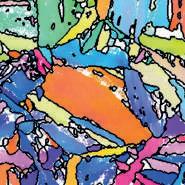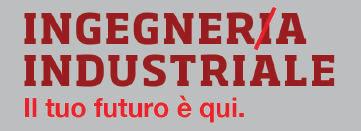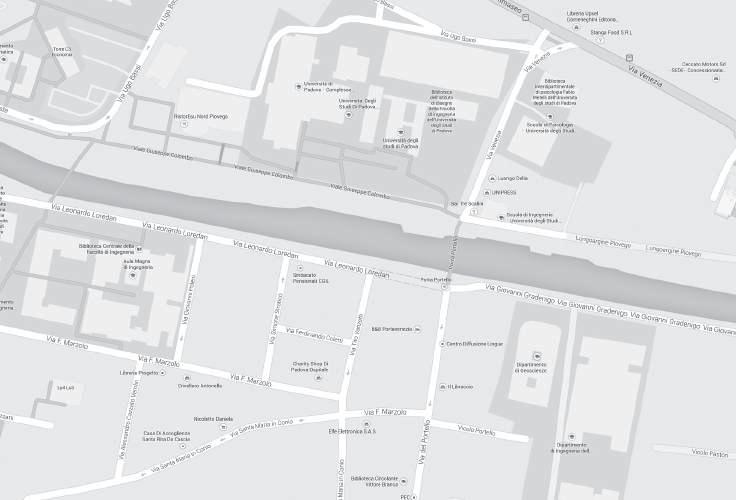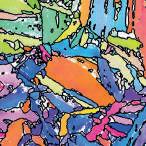DIINFORMA
EBSD mapping of austempered steel

INDUSTRIALE
APRILE 2023 01.9
NEWSLETTER DEL DIPARTIMENTO DI INGEGNERIA
DELL’UNIVERSITÀ DEGLI STUDI DI PADOVA
Mappa EBSD della microstruttura bainitica di un acciaio austempered
EBSD map of the bainitic microstructure of an austempered steel
Mechanical Systems
Fracture mechanics-based analysis for estimating the fatigue limit of Ti6Al4V alloy specimens produced by SLM in as-built surface conditions by means of areal measurements
Aerospace Engineering
DOCKS: a smart docking system for microsatellites
Bioengineering, biotechnology and health technologies
A novel arti cial urinary sphincter and comparison with reference device
Mechanical Systems
Steering-assistance systems for enhancing stability and handling of powered two-wheelers
Materials
Surface integrity and superelastic response of additively manufactured Nitinol after heat treatment and nish machining
Mechanical Systems
Differentially at robots with joint compliance
Industrial processes and products
Economic and Environmental Optimisation of Mixed Plastic Waste Supply Chains in Northern Italy

Speciale - Open Day DII: il Dipartimento aperto agli studenti delle scuole superiori
Speciale - DIIvulgazione & DIIsseminazione: il progetto Terza Missione del DII
COPERTINA DII NFORMA
Cover Story 3 PAGINA 4 5 6 7 8 9 10 12 11
e peculiar surface of as-built components manufactured by Laser Powder Bed Fusion (LPBF) is known to be one of the most predominant factors that negatively affect fatigue behaviour. e present research addressed the estimation of the fatigue thresholds of as-built components produced by Selective Laser Melting (SLM). Fracture mechanics parameters based on areal measurements were adopted because they are the most appropriate metrological parameters to describe the surface features of SLM components. Since it is well known that the high-cycle fatigue fracture initiates from the largest surface defect, evaluating the size of the largest surface defect is of paramount importance. According to the literature, the maximum pit depth measured within a control area, Sv, was found to be the most promising areal parameter for being used with fracture mechanics approaches. However, measuring the maximum Sv over the entire surface of a full-scale component may be not affordable. erefore, this investigation adopts Extreme Value Statistics (EVS) to estimate the maximum Sv that is likely to be present in a target area A, starting from observations in a set of control areas. More in detail, a test series of AM Ti6Al4V alloy specimens was considered and the Sv parameter was measured in 10 control areas for each specimen, which was fatigue tested thereafter. For the i-th specimen, the estimated Sv,max,i present in the entire surface of the gauge part of the specimen was extrapolated from the Largest Extreme Value Distribution determined on the Sv,j values from the j-th control area. By assuming that the largest pit of the surface is a semi-circular crack with depth equal to Sv,max,i, the theoretical fracture mechanics model for estimating the fatigue threshold was found to be in good agreement with the experimental data points, thus proving that areal measurements combined with EVS are useful for estimating the fatigue limit of AM components with as-built surfaces.
Sistemi meccanici
Mechanical systems
DII research group
Costruzione di Macchine
Machine Design Tecnologie e Sistemi Manifatturieri Precision Manufacturing
Giovanni Meneghetti giovanni.meneghetti@unipd.it
Phone: +39 049 8276751
Phone: +39 049 8276814
Phone: +39 049 8276796
Filippo Coppola lippo.coppola@unipd.it

Phone: +39 049 8276771
https://research.dii.unipd.it/costrmac/ https://research.dii.unipd.it/tecno
Main research topics:
• Fatigue design of mechanical components and structures
• Fatigue design of welded structures
• Materials characterization for structural integrity
• Development of energy-based methods for fatigue lifetime estimation of mechanical components

• On-road loads acquisition and bench testing of vehicles
• Structural integrity of additively manufactured metals and polymers
• Study and development of bio-mechanical structures for Sports and Rehabilitation
• Development of methods for the static and fatigue strength assessment of polymer components
• Digitization of manufacturing processes


• Additive manufacturing process chains
• Areal surface topography characterisation

3
Daniele Rigon daniele.rigon@unipd.it
DIINFORMA
Fracture mechanics-based analysis for estimating the fatigue limit of Ti6Al4V alloy specimens produced by SLM in as-built surface conditions by means of areal measurements
Enrico Savio enrico.savio@unipd.it
Sistemi aerospaziali
Aerospace systems
Flight dynamics and space systems - FLIGHTDS
DOCKS: a smart docking system for microsatellites
DOCKS is a smart docking system for space vehicles developed by the Department of Industrial Engineering, University of Padova, within the framework of the Space Rider Observer Cube (SROC) mission.. e design and development of SROC is being conducted by a consortium of Italian entities under contract with the European Space Agency (ESA).
Alex Caon alex.caon@unipd.it
Lorenzo Olivieri lorenzo.olivieri@unipd.it
Phone: +39 049 8276837
Francesco Branz francesco.branz@unipd.it




Phone: +39 049 8276779
Alessandro Francesconi alessandro.francesconi@unipd.it
Phone: +39 049 8276811
https://www.dii.unipd.it/en/ ightds
e SROC mission is designed to be a payload on the ESA Space Rider (SR) spaceship. e main objective of the mission is to demonstrate the critical capabilities and technologies required to execute a rendezvous and docking mission in a safety–sensitive context. e space system is composed by a nanosatellite (approx. 12U CubeSat) and a deployment/retrieval mechanism mounted inside the payload bay of SR. During the mission, SROC will be released by SR, will perform inspection manoeuvres on SR and, at the end of the mission, will dock back inside the bay of SR, before re– entering Earth with the mothership. e docking functionality is provided by DOCKS.

DOCKS is suitable for use onboard micro- and nanosatellites and merges a classical probe drogue configuration with a gripper–like design, to manage the connection between the parts. e system is equipped with a suite of sensors to estimate the relative pose of the target and with a dedicated computer, making it a smart standalone system. A laboratory prototype has been assembled and functionally tested, aiming at the validation of the capability to passively manage misalignments during the docking manoeuvre.
Partners and sponsors:
Politecnico di Torino (DIMEAS)
Tyvak International European Space Agency
Main research topics:
• Space debris: risk analysis, protection systems from hypervelocity impact, risk mitigation

• Active Debris Removal
• Miniaturized satellites: on-board technologies and payloads
• Systems for rendezvous and docking of satellites

4 DIINFORMA
DII research group
Luca Lion luca.lion.1@phd.unipd.it
A novel arti cial urinary sphincter and comparison with reference device
e Artificial Urinary Sphincter (AUS) is clinically considered the first-line treatment for the urinary incontinence. e design of AUS is established on different mechanisms, e.g., magnetic forces or hydraulic pressure. e success rate is deeply influenced by the mechanical stimulation of urethral tissues, which may lead to potential degenerative phenomena causing recurrent incontinence and necessary surgical revision. To minimize the risk of urethral damage, the tissue tolerability has to be considered as an essential requirement for reliability and durability of the AUS. A novel in silico strategy for AUS design has been developed to evaluate the interaction phenomena between the urethra and the device during the lumen occlusion and its subsequent opening because of bladder induced pressure. is approach has been exploited to analyse a new prototype of hydraulic AUS. e novel conformation of the cuff consists in a cylindrical chamber to be placed circumferentially around the urethra. e device entails a more uniform and safe distribution of the pressure action, without pinching of the tissue.
e development of computational models of the male bulbar urethra and the AUS (Fig. 1) made it possible to investigate the urethral mechanical response under different occlusive pressures and intraurethral actions, by varying the geometrical conformations and material properties of the prosthetic device. As an example, different elastomeric materials were assumed for the AUS by considering an hyperelastic formulation and changing the constitutive parameters. To define the design characteristics required for the continence condition, the functionality of the novel device was compared with the reference AUS AMS 800 by Boston Scientific. All the material configurations of the novel device exhibited almost the same continence performance of the AMS 800, introducing enhancements in the intensity and distribution of the compressive strain and stress within urethral tissues (Fig. 2).
e AUS design through in silico technique represents a relevant support for clinical-surgical practice in the evaluation of the most appropriate solution to be adopted, overcoming ethical tasks and limiting economic and time costs of traditional techniques.
Bioingegneria, biotecnologie e tecnologie per la salute
Bioengineering, biotechnology and health technologies
DII research group
Biomechanics

Mechanics of Biological Materials
Emanuele Luigi Carniel emanueleluigi.carniel@unipd.it Phone: +39 049 8276876
Phone: +39 049 8276754
Phone: +39 049 8276898
Joseph Vannel Fotso Fogang josephvannel.fotsofogang@ phd.unipd.it
Phone: +39 049 8276812
www.dii.unipd.it
https://research.dii.unipd.it/biomec/ www.cmbm.unipd.it

Funded by MIUR, FISR 2019, Project n° FISR2019_03221, “CECOMES: CEntro di studi sperimentali e COmputazionali per la ModElliStica applicate alla chirurgia” and by University of Padova, Project FONT_BIRD2020_01 “Characterization of Arti cial Urinary Sphincters for the identi cation of new DEVices (AUS-DEV)”.


Main research topics:
• Mechanical behaviour of biological tissues
• Constitutive modeling of biological tissues
• Computational biomechanics
• Investigation of interaction phenomena between human body and medical devices «In silico» techniques for the 3R approach to product design
Italian Patent: A novel cuff for arti cial urinary sphincter. E.L. Carniel, C.G. Fontanella, A.N. Natali. Number: IT102020000009709

5 DIINFORMA
Chiara Giulia Fontanella chiaragiulia.fontanella@unipd.it
Maria Vittoria Mascolini mariavittoria.mascolini@phd.unipd.it
Sistemi meccanici
Mechanical systems
DII research group
MMSA (Mechanism and Machine Science and Applications)
Steering-assistance
Stefano Lovato stefano.lovato.1@phd.unipd.it
Phone: +39 049 827 6810
More than 500 million of powered two-wheelers circulate worldwide, with an increasing demand for personal mobility in cities that is boosting sales for new vehicles. Two-wheelers offer advantages in terms of smaller purchase and running costs, lesser energy demand and noxious emissions, and reduced traffic congestion and parking space requirements. However, the possible loss of control in critical riding scenarios raises serious concerns about the rider's safety. Road crash statistics reveal that vulnerable road users represent more than half of all road casualties, which in 2016 reached 1.35 million worldwide.
Matteo Massaro matteo.massaro@unipd.it
Phone: +39 049 827 6792
Roberto Lot roberto.lot@unipd.it
Phone: +39 049 827 6806
Mauro Andriollo mauro.andriollo@unipd.it
Phone: +39 049 827 7706
https://www.dii.unipd.it/mmsa
This work was partially supported by a PhD grant funded by Fondo per lo Sviluppo e la Coesione (FSC), within the Piano Stralcio ‘Ricerca e innovazione 2015-2017’.


In this context, advanced riding assistance systems can potentially be employed to reduce the number and severity of road accidents involving two-wheelers, with the aim of stabilizing the vehicle in typical urban scenarios, such as low-speed riding, and during emergency braking, where stability is a fundamental prerequisite. Although assistance systems have been extensively investigated for four-wheeled vehicles, their application to two-wheelers is still in its infancy. With a target in personal mobility on public roads, the system has to satisfy several requirements. First, it must increase the vehicle stability while preserving (and possibly enhancing) the handling characteristics. Secondly, it must be fail-safe, without destabilizing the vehicle in the case of failures of sensors, controllers, or actuators. Finally, it should be as light and small as possible, with reduced power consumption.

With partial support from a PhD grant funded by Fondo per lo Sviluppo e la Coesione (FSC), the research aimed at developing an active steering-assistant system (ActiSA) for two-wheelers, which applies an assistance steering torque while maintaining the mechanical connection between the handlebar and front wheel for safety reasons. e ActiSA consists of a DC brushless motor connected to the steering column via a mechanical transmission and driven by a microcontroller according to the feedback from a set of sensors monitoring the vehicle's motion (see figure below). e prototype vehicle is based on a commercial electric bicycle. A test campaign has been recently carried out, aimed at assessing experimentally the potential of the system.
Main research topics:
• Industrial and service robotics
• Mechanical drivers and control
• Mechanical vibrations
• Mechanisms and automated machines
• Road vehicles
• Robotic systems for human interaction


6 DIINFORMA
systems for enhancing stability and handling of powered two-wheelers
Surface integrity and superelastic response of additively manufactured Nitinol after heat treatment and nish machining

is paper explores the feasibility of adopting additive manufacturing followed by heat treatment and finish machining to fabricate Nitinol components with enhanced surface integrity and more favourable superelastic characteristics.
e process chain implemented in this study to evaluate the characteristics of a Ni-rich Nitinol (hereafter named NiTi) is shown in Fig. 1 and it includes: (i) AM through the laser powder bed fusion (LPBF) technique to fabricate the near-net-shape part, (ii) heat treating to enhance the material SE, and (iii) finish machining to obtain the net-shape part and condition its surface. e same figure shows also the stress-strain path illustrating the mechanically-induced superelasticity (also known as pseudo-elasticity), intended as the material capability to undergo large deformations (more than 3%) that are fully recoverable when applying mechanical loading between austenite finish Af temperature and Md, which is the temperature at which martensite can no longer be stress-induced.
In particular, it was evident that the heat treatment after AM induces the formation of precipitates whose type, morphology and size influence the material superelastic response, whereas machining reduces the superelastic characteristics (Fig.2). Nevertheless, cryogenic machining is found to improve the NiTi surface integrity since it contribute to produce smoother surfaces characterized by a thicker severe plastically deformed layer in the correspondence of the machined surface.
DII research group
Precision Manufacturing Engineering
Rachele Bertolini rachele.bertolini@unipd.it
Phone: +39-049 8276816
Stefania Bruschi stefania.bruschi@unipd.it


Phone: +39-049 8276816
Andrea Ghiotti andrea.ghiotti@unipd.it
Phone: +39-049 8276822
This research activity has been carried out in collaboration with prof. I.S. Jawahir from the Institute for Sustainable Manufacturing (ISM) of the Kentucky University.
Main research topics:
• Manufacturing systems and processes

• Micro-technologies and precision technologies
• Shaping of metallic materials
• Processing of polymeric materials
• Geometric metrology
DIINFORMA
7
Materialigy Materials
Sistemi meccanici Mechanical systems
DII research group
Differentially at robots with joint compliance




 Matteo Bottin matteo.bottin@unipd.it
Michele Tonan michele.tonan@phd.unipd.it
Alberto Doria alberto.doria@unipd.it
Matteo Bottin matteo.bottin@unipd.it
Michele Tonan michele.tonan@phd.unipd.it
Alberto Doria alberto.doria@unipd.it
Phone: +39 049 827 6803
Giulio Rosati giulio.rosati@unipd.it
Phone: +39 049 827 6809
https://research.dii.unipd.it/mmsa/
In the robotics field, most of the robots and mechanisms are fully actuated, i.e., the number of degrees of freedom of the robot is equal to the number of actuators. us, the robot's configuration is fully determined by imposing the position to the actuators. However, a class of robots exists, the under-actuated robots, in which the number of degrees of freedom is larger than the number of actuators; in this case, the non-actuated joints cannot be directly controlled. When an under-actuated robot with n-dof and n-1 actuators is designed with specific design criteria and inertial properties of the links, it becomes differentially flat. In such a case, the non-actuated joint, which is equipped with a torsional spring, can be controlled by the motion of the actuated joints. Previous works have already addressed the control of under-actuated systems. Such works have focused on joint compliance only in the non-actuated joint, considering the actuated joints as ideally rigid. However, the elastic compliance of the actuators, which in general is lower than the one the non-actuated joint, in some applications cannot be neglected. For example, if the robot has long links and it is required to perform high accuracy fast movements, joint elastic compliance can produce undesirable vibrations, overshoots, and steady-state errors in the control response, which are hard to be compensated for. is is true both for under-actuated robots and for fully-actuated robots. e result is the introduction of additional degrees of freedom to the structures (i.e., the oscillation of each actuated joint), which yields additional under-actuation to the robot structure. As a result, even fully-actuated robots must be regarded as under-actuated, since each joint can be considered to have two independent motions, the former controlled by the actuator, and the latter which results from the elastic compliance of the joint. Nonetheless, if the robot is designed to be differentially flat, joint compliance can be included in the control system, thus allowing complete control of the robot and avoiding vibrations. In this research, the effect of joint compliance in differentially flat robots is investigated. Mathematical models are proposed, and such models are studied with numerical simulations. Both classic under-actuated and fully-actuated robots are considered, thus the applicability of the proposed models is wide. Numerical simulations highlight the effect of joint compliance in the precision of point-to-point motions of differentially flat robots.
Main research topics:
• Kinematics, dynamics and control of mechanisms and machines.
• Industrial robotics and exible automation.
• Modal analysis and vibrations.
8 DIINFORMA
Phone: +39 049 827 6716
Mechanism and Machine Science and Applications
Economic and Environmental Optimisation of Mixed Plastic Waste Supply Chains in Northern Italy


Plastics are the world's largest synthetic consumer product. However, the same resilient properties that lead to high annual production (reaching 390 million tonnes in 2021) also create a major environmental problem when it comes to the end-of-life management. e recycled post-consumer plastics are mainly mechanically recycled, which is often difficult due to downcycling. Relying on mechanical recycling alone is not sufficient to cope with the increasing volume of plastic waste. Although incineration recovers the energy stored in plastic waste, chemical recycling (pyrolysis and gasification) is emerging as an important alternative in the transition towards a circular economy.
Supply Chain (SC) optimization raises as an important research topic in achieving an efficient plastic circular economy, and it allows assessing both the optimal selection of mixed plastic waste (MPW) treatment technologies and an optimal distribution of the material flows among the different stages of the SC. Mixed integer linear programming (MILP) models are powerful mathematical optimization tools that can deal with the MPW SC combinatorial complexity.
e stages of the MPW SC (Figure 1) are divided into the transport of plastic packaging waste (PPW) from provinces to sorting centres, where PPW share that can be mechanically recycled is separated from the residual part, the MPW. From the sorting centres, the MPW fraction will end up in a treatment plant (incineration, gasification, pyrolysis), whose outputs are: electric power in the case of incineration and gasification, and oil in the case of pyrolysis plants, to be transported to a refinery for further processing.
is study proposes a economic and environmental optimisation of Northern Italy MPW SCs (in terms of maximising the annual gross profit, and minimising the GHG emissions). e outcomes provide quantitative information on the SC in terms of economic and environmental results and technology selection under different scenarios.
Fabrizio Bezzo fabrizio.bezzo@unipd.it
Phone: +39 049 827 5468
https://research.dii.unipd.it/capelab/

Main research topics:
• Mixed Plastic Waste
• Chemical Recycling
• Waste to Energy
• Supply Chain Optimisation


9 DIINFORMA
research group Processi e prodotti industriali Industrial processes and products
CAPE-Lab Computer-Aided Process Engineering Laboratory DII
Federico d’Amore federico.damore@unipd.it
Daniel Crîstiu daniel.cristiu@phd.unipd.it
Open Day DII: il Dipartimento aperto agli studenti delle scuole superiori
Il 24 marzo si è tenuto il primo Open Day DII, evento di orientamento dedicato a studentesse e studenti delle scuole superiori. Hanno partecipato al Open Day quasi 400 persone, tra studenti, genitori e insegnanti provenienti da diverse regioni, che hanno avuto la possibilità di conoscere le attività didattiche e di ricerca del dipartimento. Nella prima parte dell’evento sono intervenuti i presidenti dei corsi di laurea in ingegneria aerospaziale, ingegneria chimica e materiali, ingegneria dell’energia e ingegneria meccanica (proff. Ugo Galvanetto, Irene Calliari, Roberto Benato, Giovanni Meneghetti) per presentare l’offerta formativa. I partecipanti hanno poi potuto visitare i laboratori, interagendo con docenti e ricercatori di varie aree scientifiche del DII, e seguire le presentazioni dei progetti studenteschi, interagendo con i team di studenti in essi coinvolti.


Per la realizzazione del Open Day DII è stato fondamentale l’apporto di tutor e dottorandi, che hanno gestito i desk per la registrazione all’evento e guidato i gruppi di partecipanti (circa 120 persone) durante le visite ai laboratori.


Confidiamo che la giornata sia stata un utile momento di incontro con studenti, genitori e insegnanti, per arrivare ad una scelta informata e consapevole del percorso di studi.
L'evento è stato coordinato dalla Commissione Orientamento del DII, composta da: Andrea Bagno, Roberto Benato, Enrico Bernardo, Giacomo Colombatti, Federico Moro, Daniele Rigon.
DIINFORMA
10 Speciale
DIIvulgazione & DIIsseminazione: il progetto Terza Missione del DII
Grazie al contributo dell’Ateneo per il «Progetto Terza Missione 2022», il Dipartimento di Ingegneria Industriale ha avviato alcune iniziative finalizzate alla comunicazione delle proprie attività di ricerca e trasferimento tecnologico nell’ambito del progetto «DIIvulgazione e DIIsseminazione», sostenuto dalle associazioni Amici e Alumni dell’Università di Padova. Oltre alla periodica pubblicazione di questa newsletter, il DII, per il tramite della Commissione Terza Missione e Comunicazione, ha curato la brochure su «La Ricerca e il Trasferimento Tecnologico al DII», disponibile anche in formato digitale; ha realizzato 6 pillole video con altrettanti testimoni, scelti tra i laureati in ingegneria industriale (accessibili nelle prossime settimane sui social del DII); ha concepito e realizzato un cortometraggio che è stato presentato in prima assoluta presso il cinema MPX di Padova il 26 marzo 2023. Si tratta di un modo originale per avvicinare gli interlocutori del territorio (cittadini, studenti e famiglie, associazioni, ordini professionali ed imprese) alle attività di ricerca scientifica e di sviluppo tecnologico realizzate dal DII. È stata prodotta una vera e propria opera narrativa cinematografica, avvalendosi di uno dei più grandi protagonisti del teatro e del cinema oggi in Italia, l’attore Roberto Citran nel ruolo di un investigatore privato cui è affidato il compito di portare a termine un’indagine all’interno dei laboratori del DII.
«Abbiamo voluto declinare in modo originale il compito di comunicare all’esterno dell’Università, non solo al mondo delle imprese ma anche al pubblico in generale, il contenuto delle attività di ricerca che vengono svolte nei laboratori del DII - spiega la prof.ssa Stefania Bruschi, direttore del DII - Si tratta di attività che spaziano dalla bioingegneria alle tecnologie per la salute, dall’ambiente e sicurezza all’energia, dall’innovazione di materiali prodotti e processi alla automazione, dai sistemi meccanici a quelli elettrici, dai vettori aerospaziali alla gestione strategica di impresa. Sono tutte tematiche di forte impatto sociale, destinate ad avere effetti importanti sulla qualità di vita di tutti noi. Abbiamo così creato una storia e l’abbiamo affidata a Roberto Citran, che ha interpretato il ruolo di un detective “alla ricerca del futuro”: è al futuro, infatti, ad un futuro migliore del presente, che si rivolge l’impegno di tutti coloro che sono impegnati nella ricerca».
Il cortometraggio è stato diretto da Ivan Maniezzo e prodotto da Imago Magica da un’idea di Andrea Bagno e Massimo Malaguti.

La premiere ha visto la partecipazione di un folto pubblico ed erano presenti, tra gli altri, la prof.ssa Monica Fedeli (prorettrice alla Terza Missione), il prof. Fabrizio Dughiero (prorettore ai rapporti con le imprese), il vicesindaco di Padova Andrea Micalizzi, e l’ing. Gianni Dal Pozzo (presidente dell’associazione Alumni). Erano in prima fila e sono poi intervenuti il regista Ivan Maniezzo, con la produzione e l’intera troupe, oltre al protagonista Roberto Citran, che alla fine si è intrattenuto con il pubblico presente.


Il cortometraggio è disponibile nel canale YouTube del DII, dove verrà pubblicato tutto il materiale video realizzato nell’ambito del progetto «DIIvulgazione e DIIsseminazione».

DIINFORMA
11
Speciale
La platea e il proscenio del Cinema MPX.
Andrea Bagno, Fabrizio Dughiero, Stefania Bruschi, Monica Fedeli, Gianni Dal Pozzo, Andrea Micalizzi
Roberto Citran e Ivan Maniezzo
In primo piano la prof.ssa Stefania Bruschi
Cover story
Mappa EBSD (IPF) ottenuta su una microstruttura bainitica dopo trattamento di austempering a 300 °C. Il trattamento è stato realizzato nell’ambito dello studio dello sviluppo di un acciaio bainitico ad alto silicio, in merito ad una collaborazione con Pascal Jacques (UCLouvain, Louvain la Neuve, Belgio), che ha come obiettivo quello di sviluppare acciai per stampi per la lavorazione di materie plastiche e per l’ambito ferroviario. La microstruttura al termine del trattamento isotermo si costituisce di ferrite bainitica e cementite austenite residua.


www.dii.unipd.it
Mattia Franceschi
Mattia Franceschi si laureato in Ingegneria dei Materiali presso l’Università degli Studi di Padova e ha svolto il dottorato presso la scuola di dottorato in Ingegneria Industriale presso l’Università degli Studi di Padova tra il 2019 e il 2022. Il suo Progetto di dottorato ha riguardato lo sviluppo e lo studio di acciai alto resistenziali innovativi con microstruttura bainitica per applicazioni ferroviarie e offshore. Attualmente è assegnista di ricerca presso il Dipartimento di Ingegneria Industriale e lavora nell’ambito delle saldature e dei processi termomeccanici di acciai altoresistenziali.

Direttore: Stefania Bruschi
Vicedirettore: Piergiorgio Alotto
Segreteria amministrativa: Paolo Rando

SEDI
DII
Dipartimento di Ingegneria Industriale, Università degli Studi di Padova
Sede legale e amministrativa Via Gradenigo, 6/a - 35131 Padova
tel. +39 049 8277500
fax +39 049 8277599
segreteria@dii.unipd.it
www.dii.unipd.it



Via Marzolo, 9 - 35131 Padova
Via Venezia, 1 - 35131 Padova
DIPARTIMENTO DI
INDUSTRIALE
INGEGNERIA
































 Matteo Bottin matteo.bottin@unipd.it
Michele Tonan michele.tonan@phd.unipd.it
Alberto Doria alberto.doria@unipd.it
Matteo Bottin matteo.bottin@unipd.it
Michele Tonan michele.tonan@phd.unipd.it
Alberto Doria alberto.doria@unipd.it


















